Bath, as noted in my previous post, is a lovely place. It’s also quite old, dating back to the Iron Age when the settlement was called Bah. This was because they didn’t have a word for “A really pretty place but of limited use,” so when people asked what the area was called they just said, “Bah.” Eventually a settlement grew up around the River Avon and, because “Bah by the River Avon” was too long to chisel into the “Welcome to the Town Of…” sign, they just called it “Bath.”
Bath was discovered by the Romans who assumed, because of the name, that there would be baths there. Imagine their disappointment. So being the world-class engineers that they were, they diverted the hot springs from Hot Springs, Dorset, to the now aptly named town of Bath. Hot Springs, Dorset, naturally, fell on hard times with the loss of the mineral water trade, and is now known as Lyme Regis.
(Incidentally, this is the same thing that happened at the town of Battle in East Sussex; the Normans and the English were looking for a place to have the battle of Hastings and, even though Battle is some miles away, they decided it was too good an opportunity to pass up, so the armies marched out to the marshy fields around Battle and, well, had their battle. But the march tired out Harold’s men and that was why the English lost.)
So the Romans built the baths at Bath and took their baths there and the fortunes of Bath rose, as did several temples, an abbey, Marks and Spencer, an architecturally sympathetic Waitrose and at least one proper cigar shop.
In 1987, in recognition of its outstanding retail appeal (they have a Next, an East and even a Paperchase), Bath was named a World Heritage Site, ensuring the livelihoods of architectural restoration tradesmen throughout Somerset for many years to come.
(Editor’s Note: none of that is actually true.)
 |
| Just a random street in Bath; really, just about any place is pretty. |
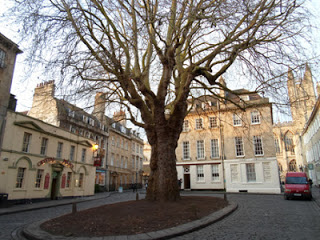 |
| Abbey Green, a quaint and quiet little cul-de-sac. |
 |
Because of the tourist trade and their connection to Roman Britain,
people are encouraged to walk around dressed as Roman Centurions. |
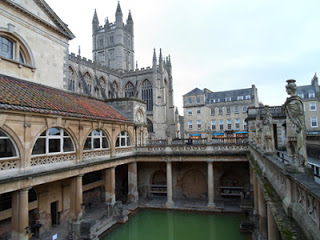 |
| The main bath with the Abbey in the background; truly stunning. |
 |
| This is another of the baths, a pool fed by hot springs for a jacuzzi-like experience. |
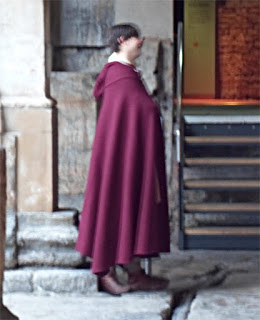 |
| See, I told you… |
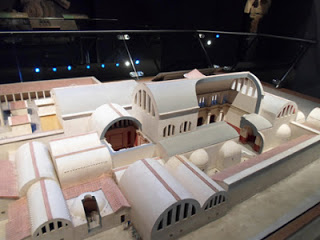 |
One of the things that surprised me was how big the bathing complex was;
the building in the middle with the roof cut away is where the first photo was taken. |
 |
No trip to Bath is complete without a visit to the oh so elegant Pump Room.
This is where Jane Austin and her set hung out. When I entered the room,
the music was loud and I told my wife I was going to ask them to turn it down.
Then I saw these guys. |
 |
| Of course you must have a Bath Bun while you are there! |
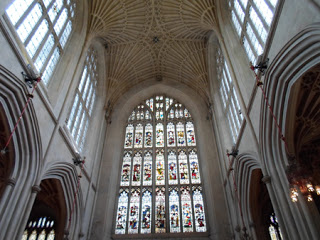 |
| Um, there\’s an abbey; sorta okay, but York Minster was better. |
 |
Although, Bath Abbey does have this: the holy relic of the
Justin and Janet Wardrobe Malfunction. |
 |
This is the Circus, after the elephants have all gone home.
This ring of Georgian houses was build by John Wood Sr. & Jr.
1754 thru 1769 |
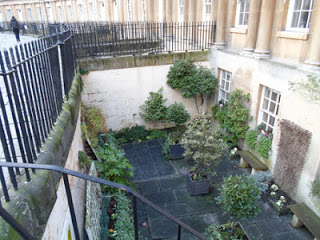 |
Even the basement apartments are luxurious, though they
call them Garden Flats. |
 |
This stunning semi-circle of Georgian homes, just down the street
from the Circus, is the Royal Crescent. When they use it as a
backdrop for period dramas, they make everyone move their cars. |
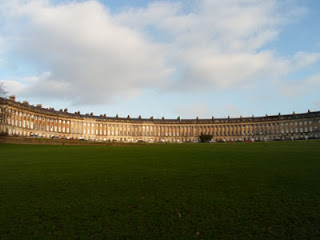 |
It is a fabulous bit of work, but it was supposed to be a full circle.
John Wood, Jr built this in 1767 thru 1775 and was determined to
show up his dad by making this a hug circus. But then he ran
afoul of the zoning commission so he just completed half of it,
called it a crescent and said he meant to do it that way.
(Editor\’s note: he\’s doing it again.) |
 |
There is no reason for this photo other than to show my friends
back in New York what winter in southern England is like. |
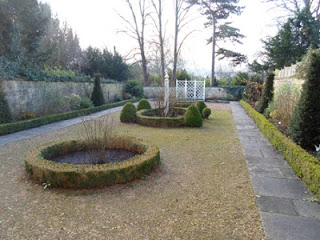 |
This is an authentic recreation of a Georgian Garden, at the
rear of Number 4, the Circus. Notice the lack of grass; that is
because they hadn\’t invented lawn mowers yet.
(Editor\’s Note: that is actually true.) |
 |
This is the oldest house in Bath, which means, in 1482, there was just
this house sitting by itself near the river with nothing but fields around it.
(Editor\’s Note: this, actually, is not.) |
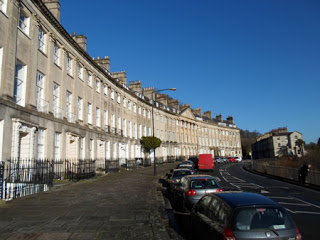 |
Almost anywhere you go in Bath there are stunning sights.
We ran across this–Camden Crescent–during an aimless ramble. |
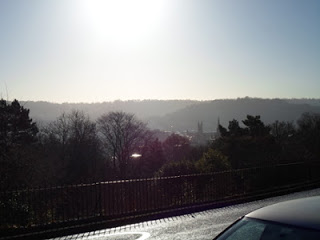 |
This is the view the people lucky (and rich) enough to live
in Camden Crescent have. |
 |
| The Pulteney Bridge. |
 |
| On the bridge; I walked across it without knowing it was a bridge. |
 |
| How many beers did it take to make this sign necessary? |
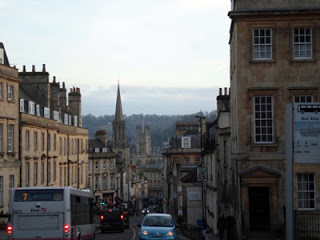 |
| View as we walked down the hill on the way to the station. |
 |
| One last glimpse at a very beautiful and historic city. |
Sorry about all the photos, but I hope you enjoyed looking at them as much as I enjoyed taking them. And, really, you need to get to Bath.

























14 Comments
Methuselah
Very scenic place. You forgot to mention, however, Bath's most famous historical fact: it's the only city in the world that is married. Many cities around the world have sister cities, but as Chaucer informed us in the Canterbury Tales, Bath has The Wife of Bath. So deal with that, all you loser bachelor cities! Enjoy your single-serving TV dinners.
MikeH
Good one, Tim. How did I miss that one!Mike–chagrined
Ms Sparrow
Thanks for the lovely tour. My daughter and I visited Bath ten years ago and it was great. We stayed at a bed and breakfast just a short walk from the Royal Crescent (I think). There was a hotel on one end of it.
MikeH
Glad to hear you had a good trip; it is such a lovely place.
MikeH
I also forgot to mention this: in the tourist shops (and there are many) you could buy a Bath bell, a Bath thimble, a Bath thong, etc. But nowhere did I see a Bath bath towel, or a Bath bath mat for sale; how did they miss this golden opportunity?
janerowena
It's lovely in the summer, when all the buildings look golden in the sunlight, especially early morning or early evening. It reminds me of parts of Italy.
MikeH
Yes, even in the winter sun, the stone buildings were pretty spectacular.
Mrs Baum
Thanks for the photos – it's lovely to see bits of the old place. I must go back for a visit sometime soon.I like the idea of the Bath bath towel etc – they're definitely missing a trick. Don't think I ever ate a Bath bun though, in the 3 years I lived there. Too busy eating Schwartz burgers (near the theatre – best burgers anywhere).
Unknown
Do not apologise I loved them all and it may be my fave city in the world.
MikeH
Schwartz burger? Missed opportunity there; maybe next time.
MikeH
It is a lovely place; I can't believe it took me over 10 years to visit!
Abigail Young
I love your photos, Mike! Plus the editorial comments 😉 How was the Bath bun?
MikeH
The Bath Bun was delicious, but you need to watch out for the lump of sugar in the middle.
Lokenrc
Story from the Imperial British days in India :British Office Superintendent, a native of Bath goes on 6 weeks’ home leave, leaving explicit instruction to Bengali Head Clerk not to leave station during his absence. Next weekend, Head Clerk bunks to his village home. After 4 weeks, Superintendent called back from leave to find Head Clerk missing. Asst Head Clerk sends telegram “BOSS RETURNED FROM BATH. VERY ANGRY. COME SHARP” (telegrams go in all caps). Telegram typed by Morse operator in village post office “…..VERY HUNGRY …..”. Head Clerk’s mother, wife, indeed entire village panic. Bengalis have lunch after bath. Since western people are said to eat anything & everything (like beef – shunned by Hindus, pork – shunned by Muslims, frog legs – shunned by all Indians), all assume Suptd ‘hungry’ for lunch after ‘bath’ & will eat Clerk. Howls of anguish from villagers & loud laments of mother & wife convince Clerk to abandon job & get lost in distant pilgrimage.This is how the city of Bath become well known in Bengali literature